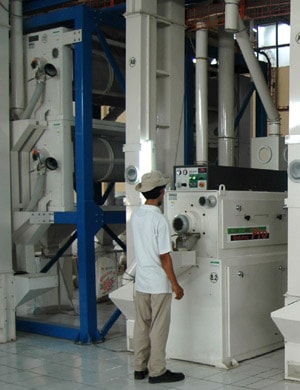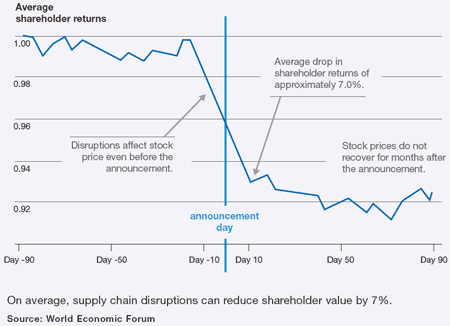BUILDING IN RESILIENCE
By Karen Kroll
Creating a flexible, robust supply chain is key to reducing the likelihood and potential impact of disruptions.

Effectively managing supply chain risk, while always important, is becoming increasingly critical. Companies are sourcing materials from an ever-expanding universe of suppliers, boosting the complexity of their supply chains. Chasing lower-cost suppliers, they look increasingly to emerging markets.
Often these markets are characterized by greater political instability and poorer infrastructure—increasing risk, says Eric Jones, assistant VP and manager, business risk consulting group with US insurer FM Global. Plus, as companies expand, they tend to make a greater number of decisions locally. That strategy can make sense, but often the decisions aren’t made with a great emphasis on risk, nor are they communicated to the corporate risk management department. The result? “It [becomes] hard to get a good understanding of risk around the world,” Jones says.
Decreasing product life-cycle spans—as companies try to respond dynamically to changing markets—are also adding to supply chain complexity, says Kelly Marchese, principal with Deloitte Consulting. “Every time a change is made, it impacts production, possibly regulation.”
Perhaps it’s not surprising that nearly half—48%—of the respondents to a recent Deloitte survey indicated that the frequency of supply chain disruptions with negative financial consequences had increased over the past three years.
Because supply chains now are so complex and fast-changing, “a check-the-box, annual review of risk is not enough,” Marchese notes. Organizations need to shift from managing supply chain risk to instituting supply chain resilience, she adds. The difference? The approach is more dynamic, allowing for fine-tuning in real time. “It’s a way of operating. If your supply chain is resilient, you can see things coming and respond.”
One key is obtaining and leveraging information. “Visibility within the supply chain tends to be the solution to any disruption,” says Sean Doherty, director of supply chain and transport industry with the World Economic Forum. “When you have information, people can manage.”
Companies that work with multiple tiers of suppliers need to know their suppliers’ suppliers: who they are, where they’re located, and the risks around them. Often, it can be vendors several steps down the chain that are hardest to replace.
 |
|
Creaturo, II-VI: If there’s a disruption, we have a fair degree of flexibility to deal with it |
However, three-quarters of suppliers don’t manage below their first-tier suppliers, a recent report by consulting firm Capgemini found. “If you don’t know what you don’t know about your supply chain, it is impossible to proactively address risk,” says Shanton Wilcox, US principal, supply chain management, with the consulting and research firm.
Supply chain mapping—the process of reviewing each material purchased, identifying which ones are critical and which are commodities, and therefore more easily replaced—can alleviate this. The idea is to pinpoint those suppliers for which a disruption in operations would materially impact your company’s revenue or profitability, Jones says.
These crucial suppliers may not necessarily be those with which the company spends the most money. “You need to have an understanding of your weakest link,” says Gerry Fay, chief global logistics and operations officer with Avnet, a $25 billion global distributor of electronic components with headquarters in Arizona. For instance, Avnet wants to know if its suppliers of cutting-edge technology have multiple manufacturing operations. If not, Avnet checks the risk mitigation plan the company has in place. “Look at the 20% of suppliers that cause 80% of the risk and manage them,” Fay advises.
This approach often requires categorizing suppliers as single- or sole-source, Jones says. Single-source suppliers provide all a company’s needs for a certain product, although other suppliers are available. Sole-source suppliers are the only source available for a product. Often, that’s because the technology is complicated or logistics makes turning to a different supplier impractical.
 |
|
Fay, Avnet: Look at the 20% of suppliers that cause 80% of the risk and manage them |
Management at II-VI Incorporated, a US-based provider of engineered materials and opto-electronic components, decided to acquire several of the companies that had been supplying it with its most important raw materials, such as selenium, says CFO and treasurer Craig Creaturo. “We’ve done that where there are limited options available to us,” he says. “It made more sense for us to do it ourselves, to secure the supply and lower the cost.”
Companies should also put in place mechanisms that allow them to monitor events likely to affect their most important suppliers. For instance, some firms with suppliers in Asia monitor the emergency warning systems in that region of the world, in order to get a handle on potential impending natural disasters.
Hunt Imaging, a producer of dry and liquid toners, has had some of its purchases of raw materials from Asia held up by dock worker strikes, notes Mike Stanek, vice president and chief financial officer with the US company. And because some of Hunt’s suppliers and customers have implemented just-in-time approaches to inventory management, “any hiccup can throw a real monkey wrench into the whole chain.”
“The use of lean techniques [like just-in-time] can improve efficiency, but reducing the level of buffers may increase risk,” adds Stephane Crosnier, managing director of operations and process with consultancy Accenture.
To combat the risk that a strike or other disruption will upset the supply chain, Stanek and his team monitor news and events in the region. If a delay seems imminent, he’ll offer customers several options: those with enough product on hand may try to wait out the strike, while others may decide to have their products transported by air.
CREATING FLEXIBILITY
Once a company has a handle on its most critical suppliers’ risk exposures, the next step is building flexibility into the supply chain. For their most critical products, companies should have at least two supply sources, according to Barry Cross, professor of operations management and technology at Queen’s University School of Business in Canada. “Build some redundancy into the supply chain. If it’s strategic, it’s worth a bit more cost.”
The goal is an “ability to quickly adapt the [company’s] business model and infrastructure to changing market conditions,” Crosnier at Accenture adds. At II-VI, for instance, some fabricating processes performed at the company’s operations in China also can be performed in Singapore, Creaturo says. “If there’s a disruption, we have a fair degree of flexibility.”
Other options to increase flexibility include raising the level of buffer stock and identifying alternative materials that could be used in the manufacturing process. If a company has enough leverage, it can require suppliers to put in place business continuity plans, Jones says. Equally important is vetting the plans to ensure confidence that a supplier could mount a timely recovery if its operations were damaged.
Ongoing focus and monitoring are also key, Marchese says: “You can’t just flip a switch. You have to attack the things that are most important and then bite off the next. And these things change all the time.”
THE IMPACT OF SUPPLY CHAIN DISRUPTIONS ON SHAREHOLDER VALUE




